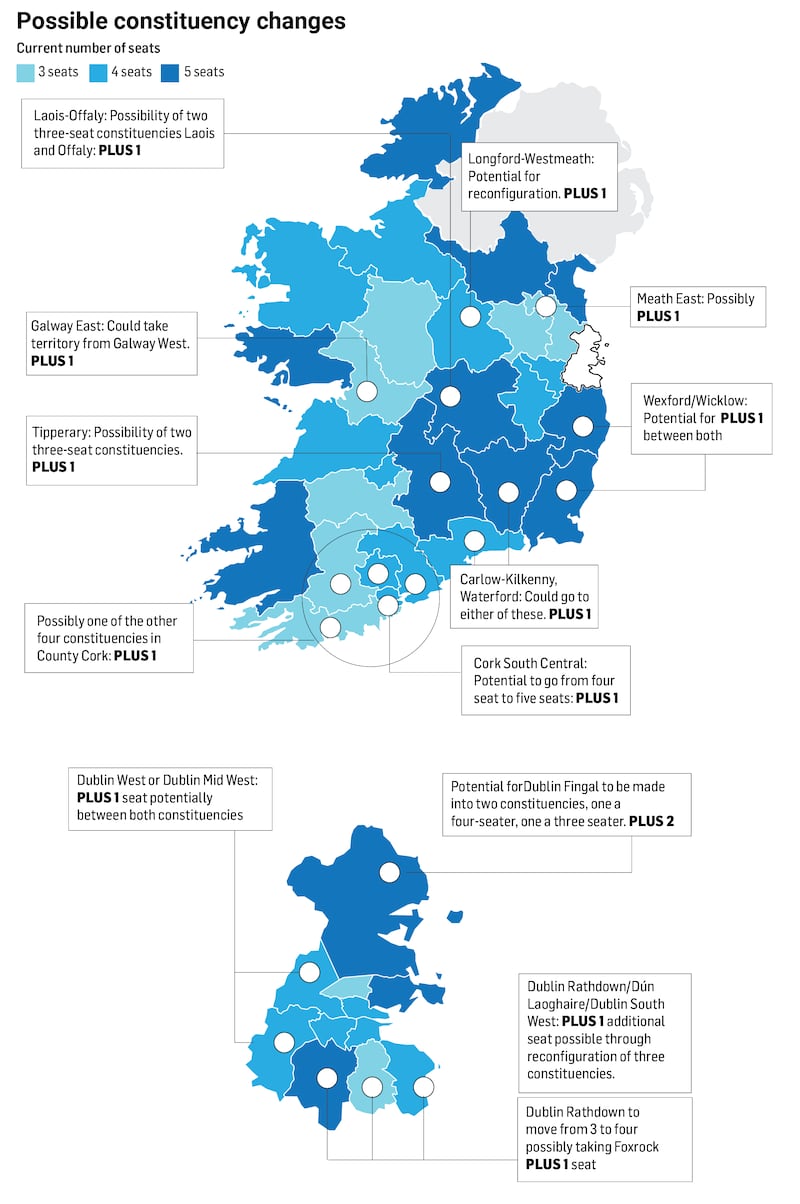The increase in Ireland’s population to more than 5.1 million means it is necessary to add more TDs to the Dáil as the Constitution says there must be one TD for every 20,000-30,000 people.
One of the first, and perhaps more challenging, tasks of Coimisiún Toghcháin, the new Electoral Commission, is to conduct a constituency review that will increase the number of TDs in the Dáil, redraw maps and change the number of TDs in certain constituencies.

The findings of the commission’s review into the reshaping of constituencies in parts of the country, which is eagerly awaited by TDs and parties across the political spectrum, will be published on Wednesday.
Currently, all but one of the 39 Dáil constituencies have more than 30,000 people per TD. The terms of its review allows the commission to increase the number of TDs in the Dáil to 171-181.
READ MORE
Each constituency can have three, four or five TDs and “the breaching of county boundaries shall be avoided as far as practicable”, the terms of the review state.
More than 500 submissions were made to the commission from politicians, political parties, members of the public, business organisations and community groups.
One of the most comprehensive submission was from Dr Adrian Kavanagh, a lecturer at the geography department at Maynooth University. He provided a detailed analysis of individual constituencies based on an assumption that the commission would ultimately opt for Dáil seat levels towards the upper end of the permitted range: either 178 seats or 180 seats.
The Dublin region should be in line to gain an extra five or six Dáil seats with some boundary redraws necessary as the new seats are allocated, he said.
Under his analysis Dublin Mid-West and Dublin South-West between them should gain a seat and there should be one additional seat in either Dún Laoghaire or Dublin Rathdown. Similarly, there should be an extra seat between Dublin South-Central and Dublin Bay South.
Mr Kavanagh suggests that the Fingal constituencies, including Dublin Fingal and Dublin West, could be in line for two extra seats overall and he offers options for how this could be done, including the possibility of creating a new constituency focused on the greater Swords area in north of the county.
Elsewhere in Leinster he suggests that with the return of territories from Louth and Cavan-Monaghan, Meath would have enough population to warrant the county getting eight seats and that both Meath West and Meath East could gain extra seats to become four-seaters.
Territory transfer
Mr Kavanagh suggests the population of Wicklow is too large to allow it to remain as a stand-alone five-seat Dáil constituency but not big enough for an extra seat.
“In this case there will need to be some territory transfer with a neighbouring county”, identifying Kildare as the “more likely candidate”, he said.
He says Carlow and Kilkenny “have between them population levels that are comfortably equivalent to six Dáil seats” and the current five-seater will have to be split into two three-seat constituencies.
Wexford “has a sufficient population level to allow it to gain an extra Dáil seat” and will similarly have to be divided into two three-seaters under Mr Kavanagh’s analysis.
“There are also complex choices” facing the commission in the West, he said; everything “hinges around what will happen with Leitrim, Sligo and Roscommon, as the decisions made in relation to these counties will have potential impacts on other counties”.
Mayo has enough population to get an extra TD to become a five-seater, as it was in 1997-2016.
What happens to Tipperary ‘could be impacted by Waterford, whose population is now too large to allow it to remain as a stand-alone four-seat Dáil constituency, but not nearly large enough to allow the county to be assigned an extra seat’
Galway has enough people to be allocated 10 Dáil seats – an increase of two for the county – and this would allow for the creation of two five-seat constituencies.
The population in Donegal is now large enough to allow this county to be once again allocated six Dáil seats, up from five and it could be split between two three-seaters.
However, Dr Kavanagh says, “whatever happens to Galway and Donegal may ultimately be shaped by the decisions made in relation to Leitrim, Roscommon and Sligo”.
[ Number of TDs in Dáil set to rise by up to 20 under electoral reviewOpens in new window ]
Roscommon’s population is too small for it to be a stand-alone three-seat constituency and the combined Leitrim and Sligo populations are too small to be a stand-alone four-seat constituency.
“One option might be to recreate the Sligo-North Leitrim and Roscommon-South Leitrim three-seat constituencies, but this was a deeply unpopular as Leitrim people believed that it effectively disenfranchised them,” he said.
Other options include using parts of counties Galway and Donegal to add population to the tricky constituency.
Munster region
Mr Kavanagh says “the task faced by the commission in redrawing boundaries in the Munster region is also quite messy”.
The population of Clare is “now too large to allow it to remain as a stand-alone four-seat Dáil constituency, but not nearly large enough to allow the county to be assigned an extra seat”.
He suggests that Clare might have to remain a four-seater and lose territory to another constituency with Limerick City said to be “a viable contender”.
Mr Kavanagh believes this would create an issue for Limerick constituencies “which ironically would be one of the few constituencies whose boundaries could be left intact, based solely on their current population levels”.
Added population from Clare would leave the combined populations in the Limerick constituencies as too large to sustain for the current seven seats but not large enough to gain an extra seat.
“This issue could be resolved by moving part of West Limerick in with Kerry to, in turn, allow for the recreation of the Kerry North-West Limerick and Kerry South three-seat constituencies that were used at the 2011 general election,” Mr Kavanagh suggests.
[ The Irish Times view on the Electoral Commission: improving our system of votingOpens in new window ]
He says Tipperary has a sufficient level of population “assuming the commission opt for 178 or 180 seats” to allow it to gain an extra seat to recreate Tipperary North and Tipperary South three-seaters.
What happens to Tipperary “could be impacted by Waterford, whose population is now too large to allow it to remain as a stand-alone four-seat Dáil constituency, but not nearly large enough to allow the county to be assigned an extra seat.”
He says the Cork region should gain two extra seats in this constituency boundary review and “there could be opportunity to align the constituency boundaries of Cork North-Central and Cork South-Central with the newly enlarged boundaries of Cork city.”
“Of the other constituencies, Cork East would have, based on population levels, the greater claim to gain an extra seat, with the other Cork seat gain to be allocated to either Cork South-West or Cork North-West,” said Dr Kavanagh.


















